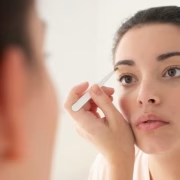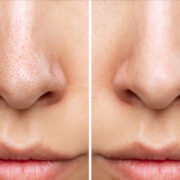A gummy smile is a condition wherein most of your teeth are covered by excess gums. It is otherwise known as Excessive Gingival Display. While it is mainly harmless and non-threatening, people associated with this condition often have their insecurities and low self-esteem rooted around their smiles. Excessive Gingival Display has proven to be more prevalent in women than men. (Silberberg, N., Goldstein, M., & Smidt, A. (2009)) Approximately 10 percent of adults in their 20s and 30s are affiliated with this condition.
What Causes a Gummy Smile?
Vertical Maxillary Excess
Different factors cause gummy smiles, but the most common one is due to vertical maxillary excess (VME).
Vertical maxillary excess, otherwise known as the long-face syndrome, is a disease characterized by excessive vertical maxillary growth, most usually classified as a skeletal kind of open bite. The occurrence of an anterior open edge is utilized to diagnose VME clinically. The intrusion of the posterior teeth is a critical component of treatment for a patient with VME and an anterior open bite. Two treatment methods were considered for the patient’s vertical maxillary excess. The first option is surgical orthodontic therapy, which entails repositioning the maxilla superiorly and posteriorly using osteotomy to minimize vertical maxillary excess and protrusion effectively. Injections of botulinum toxin or crown lengthening are ineffective in treating a gummy grin caused by vertical maxillary excess (VME). An osteotomy can effectively cure VME by reducing the maxillary vertical dimension. The alternative is nonsurgical orthodontic therapy using upper and lowers first premolar extractions with Temporary Anchorage Devices for complete dentition encroachment. (Paik, C. H., Park, H. S., & Ahn, H. W. (2017))
Hypermobile Upper Lip (HUL)
The resting and positioning of the lip is also a factor in determining what one’s smile looks like. A hypermobile lip indicates a lip that rises way too much. When someone with a hypermobile upper lip smiles, this action may cause the reveal of more gum than intended for an attractive smile. Crown height is the vertical height of the maxillary central incisors in adults; crown height is usually between 9 and 12 mm. The amount of gingival and incisor visible on the smile and crown height all contribute to determining how much tooth movement is required to increase the smile index.
People with hypermobile upper lips tend to have greater than 4 mm of upper lip length when they smile. In a research conducted by (Andijani R. I. & Tatakis D. N. (2018)), 56 people were screened, with 85.7 percent being female and 94.6 percent having gingival displays. 75.5 percent of patients with gingival display had gum length greater than or equal to 4 mm, with 45.3 percent of those caused solely by Hyperactive UL. HUL is the most common reason people seek Gummy Smile treatment, and it’s often encountered alongside APE.
Altered Passive Eruption (APE)
Teeth appear during the formative periods of our life. The two types of tooth eruption are active and passive tooth eruption. Passive eruption refers to the natural exposure of the tooth’s crown induced by apical migration of the gingival tissues. The transfer of a tooth from its developmental site in the alveolar bone to its functional position in the oral cavity is called active eruption. There are four stages of tooth eruption. The dentogingival junction is still at the enamel during the first stage of passive tooth eruption. In the second stage, the cementum is reached, followed by the cementoenamel intersection (CEJ) and, lastly, root surface exposure.
But with an altered passive eruption, the tiny bit of gingival recession, which was supposed to occur upon the last stage of the passive eruption, does not happen. Instead, excess gums wrap around the teeth, giving them a shorter and squarer look. Experts call the look a brief clinical crown appearance, making it feel like some teeth have yet to erupt. To non-experts, Altered Passive Eruption (APE) may look almost the same as an HUL. But there are varying differences!
The CEJ and alveolar crest placement must be checked when diagnosing altered passive eruption, with the lips inspected when the patient relaxes or attempts to smile.
According to (Rossi et al. (2014)), there are two types of APE. Type I is where the gingival margin is incisal to the CEJ, with short clinical crowns and a broader gingiva dimension. Type II APE is where the gingiva seems normal in size from the gingival margin to the mucogingival junction. The CEJ is incisal or occlusal to the free gingival margin, and the mucogingival junction is located at the CEJ. Two subtypes exist for Type II APE: subtype A is when a standard attachment can be found with about a 1.5mm distance between the alveolar crest and the CEJ. Subtype B is when the alveolar crest is at or above the level of the CEJ.
There are only two treatment options for individuals with altered passive eruption: a simple gingivectomy to reveal buried anatomy in type 1-A, a full-thickness flap with respective osseous surgery, and an apically relocated flap in type 2-A. (Garber and Salama, 1996)
Dentoalveolar extrusion
Dentoalveolar extrusion is due to an overeruption of one or more maxillary anterior teeth. Anterior extrusion may be caused by tooth wear or a deep anterior bite. In cases of anterior tooth wear, there is compensating incisor overeruption. Deep bite cases are distinguished by a misalignment of the anterior and posterior occlusal planes. This condition is most frequent in patients that have Class 2 malocclusion. In cases of dentoalveolar extrusion, both gingiva and the bone move with the patient’s teeth. Bottom teeth may be hidden in patients with this condition due to the concavity of the gingival line that forms due to a lack of contact between opposing teeth. Managing this problem may include repositioning the maxillary incisors or orthognathic surgery.
Overall Treatment and Options
There are treatments available, and they differ depending on the reason for the gummy smile. Veneers may be the solution for people who want to change their appearance without causing any underlying issues! Gingivectomy is a surgical technique for removing excess gum tissue or irregular tooth eruptions. Laser technology can also be used for gingivectomy. Orthodontic treatment may be beneficial for patients who have a bad bite or a jaw issue. Botox and lip realignment are two procedures that can improve thin lips. The cost and quantity of therapies are determined by the severity of the patient’s ailment.






